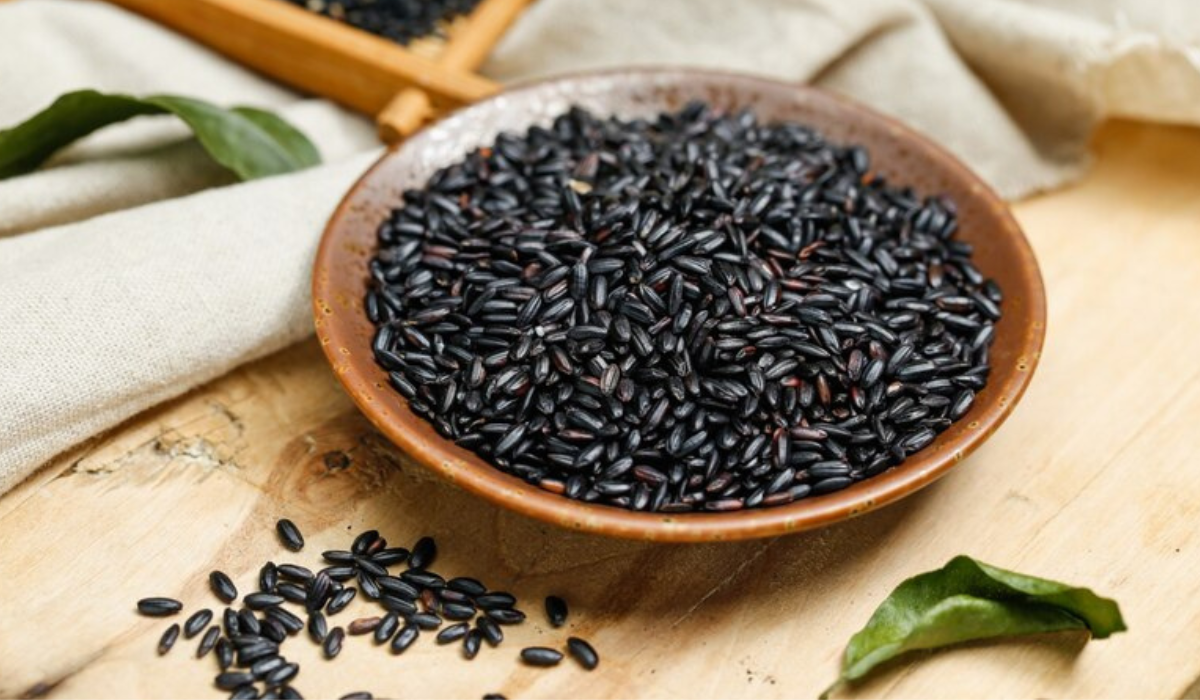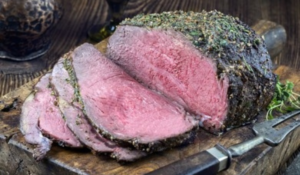Sharing is caring!
Table of Contents
ToggleIntroduction
Embark on a culinary adventure with Haitian Black Rice. This dish is more than a staple in Haitian cuisine. It’s a vibrant symbol of rich culture and history. Known locally as ‘diri djon djon’, it stands out with its black hue. The color and earthy flavors come from ‘djon djon’ mushrooms. This dish is more than a meal. It tells a story of tradition, resilience, and community. Each grain narrates Haiti’s diverse heritage. It’s a blend of African, Spanish, and French influences. These have shaped Haiti’s culinary landscape. Haitian Black Rice is not just food. It’s a celebration of life, uniting people in joy and reflection. As we explore Haitian Black Rice, we uncover its preparation secrets. We learn about the nuances of its ingredients. We understand why it’s special to those who enjoy it. Join us in discovering this extraordinary dish, a true gem in gastronomy.
Discover more about the fascinating history of Haitian cuisine here, and for an authentic recipe to try at home, visit this link.
History of Haitian Black Rice
The tale of Haitian Black Rice, or ‘diri djon djon’, is a captivating walk through history, woven into Haiti’s vibrant cultural fabric. This unique dish is known for its striking black color. It comes from special ‘djon djon’ mushrooms, native to Haiti’s northern areas.These mushrooms, when simmered, release a dark, flavorful pigment that transforms ordinary rice into an extraordinary culinary experience.
Tracing its origins, Haitian Black Rice reflects a blend of various cultural influences that have shaped Haiti’s history. The dish embodies a fusion of indigenous Taino, African, and European flavors, a testament to the island’s complex past. African slaves brought to Haiti by Spanish and French colonizers introduced techniques and ingredients that significantly influenced local cuisine. Haitian Black Rice emerged as a symbol of this cultural amalgamation, adapting and evolving with each passing generation.
Preparing Haitian Black Rice is more than cooking; it’s a ritual. It honors ancestors and celebrates Haitian heritage. This dish has endured over time, like Haiti’s resilient people. It adapts to changes while keeping its core identity.
Each serving of Haitian Black Rice is not just a meal but a narrative of survival, resistance, and pride.
Today, Haitian Black Rice continues to be a beloved dish, not only in Haiti but also in Haitian communities worldwide. It’s a culinary legacy that connects Haitians to their roots, reminding them of their history and the journey their ancestors embarked upon. As we explore the flavors and stories behind Haitian Black Rice, we delve into a rich, historical saga that is as flavorful as the dish itself.
Cultural Significance of Haitian Black Rice
Haitian Black Rice, known in Haiti as ‘diri djon djon’, is much more than a culinary delight; it’s a vibrant emblem of Haitian culture and identity. This dish, steeped in history and tradition, goes beyond mere sustenance, symbolizing the resilience and creativity of the Haitian people. In every household and community gathering, Haitian Black Rice serves as a connector to the past, a celebration of the present, and a hope for the future.
The cultural significance of Haitian Black Rice lies in its ability to bring people together. It’s a common feature at weddings, birthdays, and even funerals, marking every significant life event with its presence. This dish is a unifying force, embodying the spirit of communal dining and shared experiences that are central to Haitian life.
Moreover, Haitian Black Rice is a testament to the ingenuity of Haitian cuisine.It highlights the local ingenuity in using available resources. The ‘djon djon’ mushrooms, once humble, now create a flavorful and symbolic dish. These mushrooms have elevated Haitian cuisine, giving it rich taste and cultural value.
In the diaspora, Haitian Black Rice also plays a crucial role in keeping the connection to Haitian heritage alive. For many Haitians living abroad, preparing and sharing this dish is a way to remember their roots and share their culture with others. It’s a source of pride and a reminder of their homeland’s rich culinary landscape.
In essence, Haitian Black Rice is more than just a traditional dish; it’s a cultural icon. It represents the resilience, community, and creativity that are the hallmarks of Haitian society. As we explore this beloved dish, we delve into the heart of Haiti’s cultural heritage, discovering a story of unity, strength, and enduring tradition.
Ingredients of Haitian Black Rice
The magic of Haitian Black Rice, or ‘diri djon djon’, lies in its unique blend of ingredients, each adding its distinct flavor and character to this iconic dish. At the heart of this recipe are the ‘djon djon’ mushrooms, native to Haiti, known for imparting the rice with its signature black hue and an earthy, umami-rich flavor. These mushrooms are not just a culinary choice but a cultural emblem, deeply rooted in Haitian gastronomy.
Alongside ‘djon djon’, long-grain rice typically serves as the canvas for this dish. The rice absorbs the rich, dark pigment and flavors from the mushrooms, transforming into a visually striking and deliciously aromatic meal. The choice of rice is crucial, as it needs to maintain its texture and not become too mushy when absorbing the mushroom broth.
Aromatic spices and herbs play a significant role in elevating the flavors of Haitian Black Rice. Garlic, thyme, and cloves are common, each adding depth and complexity to the dish. These ingredients reflect the diverse influences in Haitian cuisine, blending indigenous and imported flavors harmoniously.
Additionally, Haitian Black Rice often includes a mix of bell peppers, onions, and sometimes, a hint of Scotch bonnet pepper for a subtle kick. These vegetables not only add layers of flavor but also contribute to the overall nutritional value of the dish.
Coconut oil or butter is typically used for sautéing the spices and vegetables, adding a richness that balances the earthiness of the mushrooms. In some variations, small pieces of salted pork or shrimp are included, enhancing the dish with a savory note.
Each ingredient in Haitian Black Rice is carefully chosen and plays a pivotal role in creating the dish’s distinctive taste and texture. This combination of local produce and aromatic spices results in a dish that is not just a feast for the palate but also a celebration of Haiti’s culinary heritage.
Cooking Techniques for Haitian Black Rice
Mastering the art of preparing Haitian Black Rice involves embracing traditional cooking techniques that have been passed down through generations. The process begins with the ‘djon djon’ mushrooms, the cornerstone of this dish. Chefs typically soak these dried mushrooms in hot water, a step that unleashes their rich, black pigment and intense flavor. This mushroom-infused water, rather than plain water, is what cooks the rice, imparting the signature color and earthy taste.
The technique of sautéing forms the next critical step. Cooks often start by sautéing finely chopped onions, bell peppers, garlic, and spices like thyme and cloves in coconut oil or butter. This method not only releases the aromatics’ flavors but also lays the foundation for the rice’s rich, multi-layered profile.
When it comes to the rice, the choice of grain and its preparation are key. Long-grain rice, preferred for its ability to remain firm and separate, is gently rinsed and then added to the sautéed mixture. The act of toasting the rice before adding the mushroom broth is a crucial step, as it helps to lock in the flavors and prevent the grains from becoming too sticky.
The ratio of liquid to rice is another vital aspect of the cooking process. Achieving the perfect balance ensures that the rice cooks evenly and absorbs all the flavors without becoming overly soggy. A low and slow cooking approach is often employed, allowing the rice to simmer gently in the mushroom broth, soaking up all the savory goodness.
Finally, patience is a virtue when cooking Haitian Black Rice. Allowing the rice to rest off the heat before serving is essential. This resting period lets the flavors meld together and the rice to achieve the ideal texture. The result is a dish that not only tastes exquisite but also pays homage to the traditional cooking techniques of Haitian cuisine.
Serving Suggestions for Haitian Black Rice
Serving Haitian Black Rice, a dish rich in flavor and heritage, calls for thoughtful pairings that complement its robust character. This versatile dish shines as both a main course and a side, adaptable to various culinary settings.
For a hearty meal, Haitian Black Rice pairs beautifully with proteins like grilled chicken, stewed beef, or fried fish. The savory notes of the meat balance the earthy tones of the rice, creating a harmonious blend of flavors. Vegetarians can pair it with sautéed vegetables or a hearty bean stew, ensuring a protein-rich and flavorful meal.
In traditional Haitian cuisine, this rice often accompanies dishes like griot (fried pork) or legumes, a testament to its ability to balance richer, more intense flavors. The subtle heat from the rice, thanks to the Scotch bonnet pepper, complements the sweetness and acidity of these dishes, offering a well-rounded dining experience.
For those who enjoy a bit of freshness with their meal, a side of pikliz, a spicy Haitian coleslaw, adds a crunchy, tangy contrast to the soft, earthy rice. The acidity and heat from the pikliz cut through the richness, refreshing the palate with each bite.
When it comes to presentation, Haitian Black Rice deserves a spotlight on the plate. Serve it in a mound or a neatly shaped portion to showcase its unique color and texture. Garnishing with a sprig of fresh thyme or parsley not only adds a pop of color but also a hint of freshness to the dish.
In essence, when serving Haitian Black Rice, consider the balance of flavors and textures. Whether it’s with meat, vegetables, or other Haitian classics, this dish offers a canvas for a variety of culinary pairings, each elevating its rich history and unique taste.
Variations of Haitian Black Rice
Haitian Black Rice, while deeply rooted in tradition, lends itself to a variety of interpretations that celebrate both its heritage and the creativity of modern cooks. Across Haiti and beyond, chefs and home cooks alike have embraced the essence of this dish, infusing it with personal touches and local flavors.
One popular variation involves the addition of protein directly into the rice. Shrimp or diced pork are common choices, sautéed with the aromatics before adding the rice and ‘djon djon’ broth. This method transforms Haitian Black Rice into a one-pot meal, rich in both flavor and substance.
Vegetarian versions of Haitian Black Rice are gaining popularity, especially among health-conscious and environmentally aware circles. Replacing traditional proteins with hearty vegetables like eggplant or sweet potatoes, or legumes like black beans, offers a nutritious and equally satisfying alternative. These ingredients not only complement the earthy flavors of the ‘djon djon’ mushrooms but also add a delightful texture contrast.
In some regions, chefs experiment with the spice blend, adding local herbs or adjusting the heat level to suit regional palates. This customization showcases the dish’s versatility and its ability to adapt to different taste preferences while maintaining its core identity.
Another variation is the method of cooking the rice. While traditional recipes call for simmering the rice in the mushroom broth, some modern interpretations use a rice cooker or even a pressure cooker. These methods can be more convenient and yield consistent results, making Haitian Black Rice more accessible to the everyday cook.
Each variation of Haitian Black Rice, whether it’s a tweak in the ingredients, spices, or cooking method, tells a story of adaptation and innovation. These versions not only keep the dish relevant but also allow it to be celebrated and enjoyed in new and exciting ways, by a broader audience.
Preservation of Haitian Black Rice
Preserving the authenticity and tradition of Haitian Black Rice is crucial in maintaining its cultural significance and culinary heritage. As the world becomes increasingly globalized, safeguarding this traditional dish ensures that future generations can experience and appreciate its rich history and unique flavor.
Key to the preservation of Haitian Black Rice is the continued use of traditional ingredients, particularly the ‘djon djon’ mushrooms. These mushrooms, endemic to Haiti, are the soul of the dish, and their use is a homage to the country’s natural resources and culinary traditions. Efforts to cultivate and harvest these mushrooms sustainably help maintain the dish’s authenticity and availability.
Passing down the recipes and techniques from generation to generation is another vital aspect of preservation. In Haitian families and communities, cooking is often a communal activity, a time for sharing stories, skills, and heritage. By teaching young cooks the traditional methods of preparing Haitian Black Rice, the essence of the dish remains intact.
In addition, the Haitian diaspora plays a significant role in preserving and promoting Haitian Black Rice. By preparing and sharing this dish in their new communities, they not only keep their connection to their homeland alive but also introduce this unique aspect of Haitian cuisine to a global audience.
Documenting the recipe and its history is also essential. Through cookbooks, culinary blogs, and even social media, the story and preparation of Haitian Black Rice reach a wider audience, ensuring that this traditional dish is not forgotten.
In essence, the preservation of Haitian Black Rice is a collective effort that involves sustainable practices, intergenerational teaching, and global sharing. It’s about honoring the past, celebrating the present, and ensuring that this iconic dish continues to be a part of Haiti’s culinary legacy.
Personal Experiences with Haitian Black Rice
My journey with Haitian Black Rice has been a tapestry of flavors, culture, and memories. The first time I tasted this unique dish, it was more than just a culinary experience; it was a dive into a rich cultural heritage. The earthy, umami flavor of the ‘djon djon’ mushrooms, combined with the aromatic spices, instantly transported me to the vibrant streets of Haiti.
Cooking Haitian Black Rice myself became a personal quest. Sourcing the ‘djon djon’ mushrooms was an adventure, leading me to hidden markets and conversations with local Haitian vendors. Their stories, infused with pride and nostalgia, added layers of meaning to the ingredients in my hands.
The cooking process itself was a lesson in patience and precision. Balancing the liquid to rice ratio, simmering the mixture to perfection, and letting the flavors meld, taught me the importance of respecting traditional methods. Each step was a reminder of the generations of Haitians who had passed down this recipe, a culinary heirloom.
Sharing Haitian Black Rice with friends and family brought new dimensions to my appreciation of the dish. Observing their reactions to the first bite, the surprise at the depth of flavor, and the ensuing curiosity about its origins, sparked conversations about Haitian culture, cuisine, and history.
Moreover, my experiences with Haitian Black Rice have deepened my understanding of the role food plays in cultural identity. This dish is more than sustenance; it’s a symbol of resilience, a celebration of heritage, and a testament to the creativity of the Haitian people.
In essence, Haitian Black Rice is not just a dish I cook or eat; it’s a story I keep revisiting, each time uncovering new flavors, tales, and connections. It’s a culinary journey that transcends borders and time, continuously enriching my appreciation for Haiti’s rich gastronomic landscape.
Haitian Black Rice: A Culinary Masterpiece
Haitian Black Rice, or ‘diri djon djon’, stands as a culinary masterpiece in Haitian cuisine, embodying the rich tapestry of flavors, history, and culture of this vibrant Caribbean nation. This dish, with its distinctive black hue and profound earthy taste, captures the essence of Haiti’s culinary ingenuity and the natural bounty of its land.
At the heart of Haitian Black Rice is the ‘djon djon’ mushroom, a unique ingredient native to Haiti. These mushrooms are not just a flavor enhancer; they are a symbol of Haitian resourcefulness and tradition.
When simmered, these mushrooms turn the rice a deep black. They add an intense, umami-rich flavor, making ordinary rice extraordinary.
Preparing Haitian Black Rice is a ritual. It shows the care and passion Haitians have for cooking. The process needs precision and patience. This includes sautéing aromatics and simmering the rice in mushroom broth. Such attention to detail makes each serving a feast for the senses, not just nourishing.
Moreover, Haitian Black Rice is a dish that tells a story. It speaks of Haiti’s history, from the indigenous Taino to the influences of Africa and Europe. It’s a dish that has evolved, yet retained its core identity, much like the people of Haiti. In every bite, there’s a sense of connection to the land and its history.
In essence, Haitian Black Rice is more than just a traditional dish.It celebrates Haitian culture, showing the resilience and creativity of its people. Haitian Black Rice is a treasure in gastronomy. Enjoyed in simple kitchens or fancy restaurants, it always offers a taste of Haiti’s soul.
Cooking Tips :
Mastering Haitian Black Rice requires a blend of traditional techniques and a few practical tips to ensure every batch turns out perfectly. Here are some key pointers to keep in mind:
- Quality of Ingredients: The soul of Haitian Black Rice lies in the ‘djon djon’ mushrooms. Ensure you source high-quality, authentic mushrooms for that signature earthy flavor and color. The quality of your rice is equally important. Opt for a long-grain variety that holds its shape and doesn’t turn mushy.
- Rinsing the Rice: Always rinse your rice thoroughly before cooking. This step removes excess starch, preventing the grains from sticking together and ensuring a fluffier texture in your final dish.
- Balancing the Broth: The ‘djon djon’ broth is crucial. It should be potent enough to impart flavor and color but not so strong that it overwhelms. Striking the right balance is key. If you’re new to cooking with ‘djon djon’, start with a conservative amount and adjust according to your taste.
- Sautéing Aromatics: Don’t rush sautéing your onions, garlic, and bell peppers. This process, done slowly, allows the flavors to develop fully, forming a flavorful base for your rice.
- Simmering: Once you add the rice to the pot, let it simmer gently. Resist the urge to stir frequently as this can break the grains and release starch, leading to sticky rice.
- Resting the Rice: After cooking, let the Haitian Black Rice rest off the heat, covered, for about 10 minutes. This allows the grains to settle and the flavors to meld together.
- Taste and Adjust: Don’t forget to taste your rice as you cook. Adjust seasonings as needed. Remember, cooking is an art, and your palate is the best guide.
By following these tips, you’ll be well on your way to creating a delicious, authentic batch of Haitian Black Rice that captures the essence of this beloved Haitian dish.
FAQs :
- What makes Haitian Black Rice unique? Haitian Black Rice, known for its distinctive black color and rich, earthy flavor, is unique due to the ‘djon djon’ mushrooms. These mushrooms, native to Haiti, are the key ingredient that sets this dish apart from other rice dishes.
- Can I make Haitian Black Rice without ‘djon djon’ mushrooms? While ‘djon djon’ mushrooms are essential for authentic Haitian Black Rice, you can experiment with other mushrooms for a different flavor profile. However, keep in mind that it won’t have the same traditional taste and color.
- Is Haitian Black Rice spicy? Traditionally, the dish isn’t overly spicy. However, it can contain a mild heat from ingredients like Scotch bonnet pepper. You can adjust the spice level to your preference.
- What can I serve with Haitian Black Rice? It pairs well with proteins like chicken, pork, or fish. Vegetarian options like sautéed vegetables or bean stews also go well with it.
- How do I store leftover Haitian Black Rice? Store it in an airtight container in the refrigerator for up to three days. Reheat it gently, adding a bit of water or broth to keep it moist.
- Can Haitian Black Rice be made in a rice cooker? Yes, you can use a rice cooker. Prepare the ‘djon djon’ broth separately and use it as the cooking liquid in the rice cooker. Adjust the liquid quantity as per your cooker’s instructions.
Remember, cooking Haitian Black Rice is as much about the journey as it is about the destination. Enjoy the process and the delicious results!
Conclusion
In conclusion, Haitian Black Rice is not just a dish; it’s a vibrant testament to Haiti’s rich culinary heritage. Each spoonful tells a story of tradition, resilience, and the harmonious blending of various cultural influences.
Haitian Black Rice celebrates Haitian culture and gastronomy. It gets its color and flavor from unique ‘djon djon’ mushrooms. The preparation methods have passed down through generations. Whether you’re a chef or a food lover, exploring this dish is an adventure. It invites you to try new ingredients and traditional cooking methods. You’ll appreciate the deep flavors and history in each grain. Its versatility in pairings and variations also suits any taste or occasion.
Moreover, Haitian Black Rice serves as a bridge, connecting those in the Haitian diaspora to their roots and introducing others to the rich flavors of Caribbean cuisine. It’s a dish that brings people together, fostering a sense of community and shared heritage.
As we continue to explore and celebrate world cuisines, let’s remember the stories behind dishes like Haitian Black Rice.They show us how food can cross boundaries, keep history alive, and bring joy and unity to our tables. When you enjoy Haitian Black Rice next, think about its journey. From Haitian fields and kitchens to your plate, it brings a vibrant culture’s essence.







1 thought on “Discover the Rich Flavors of Haitian Black Rice: A Culinary Journey”
Comments are closed.